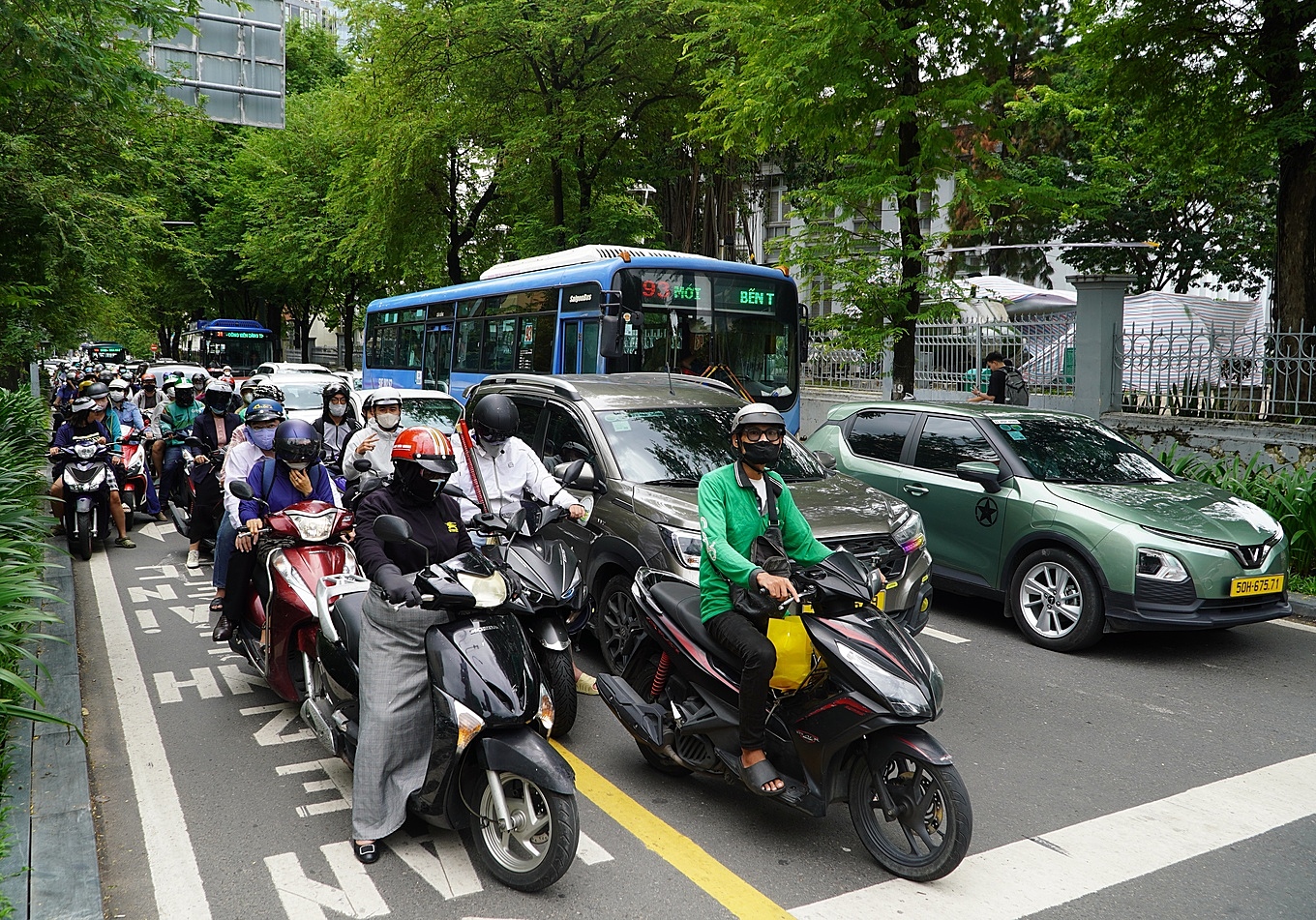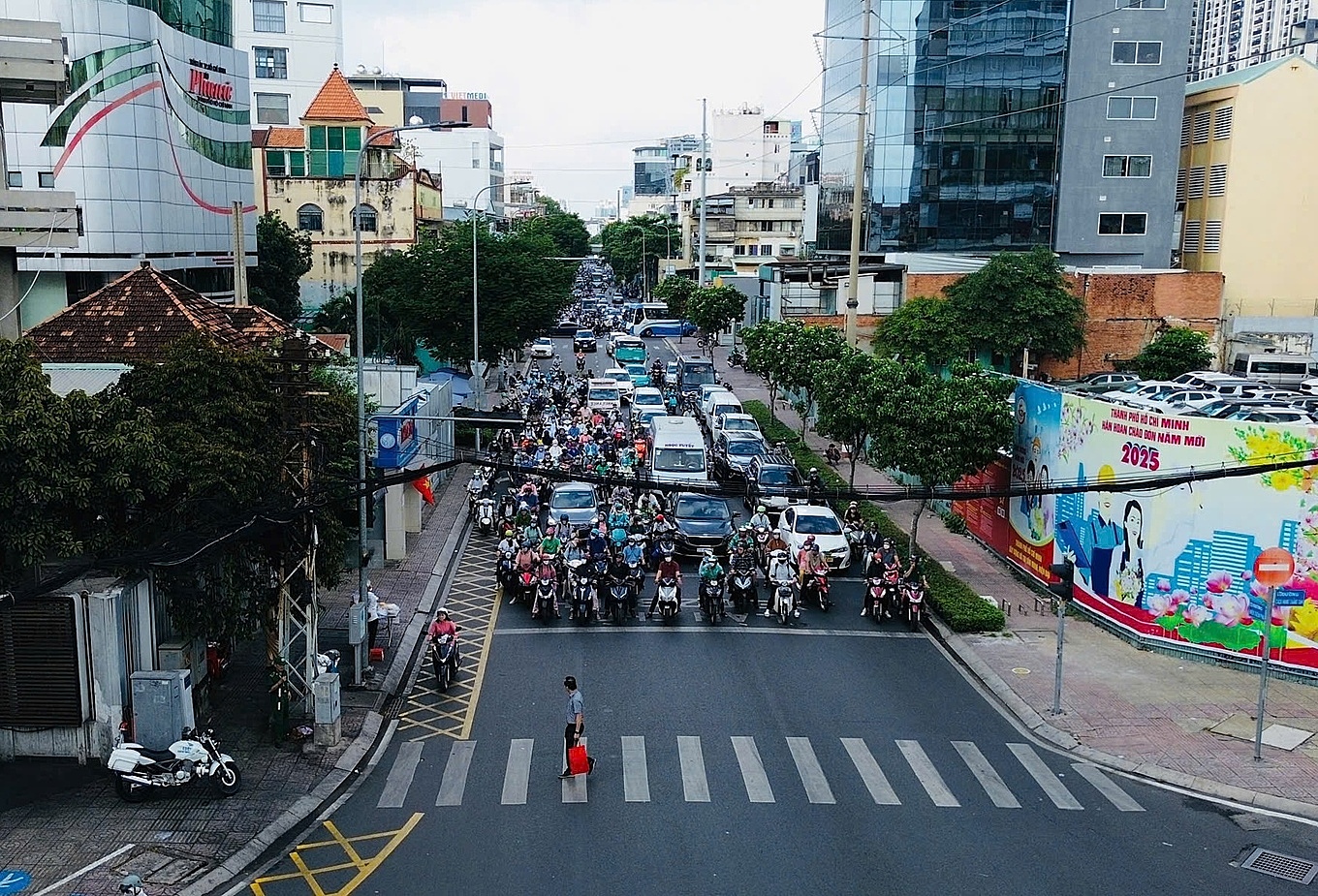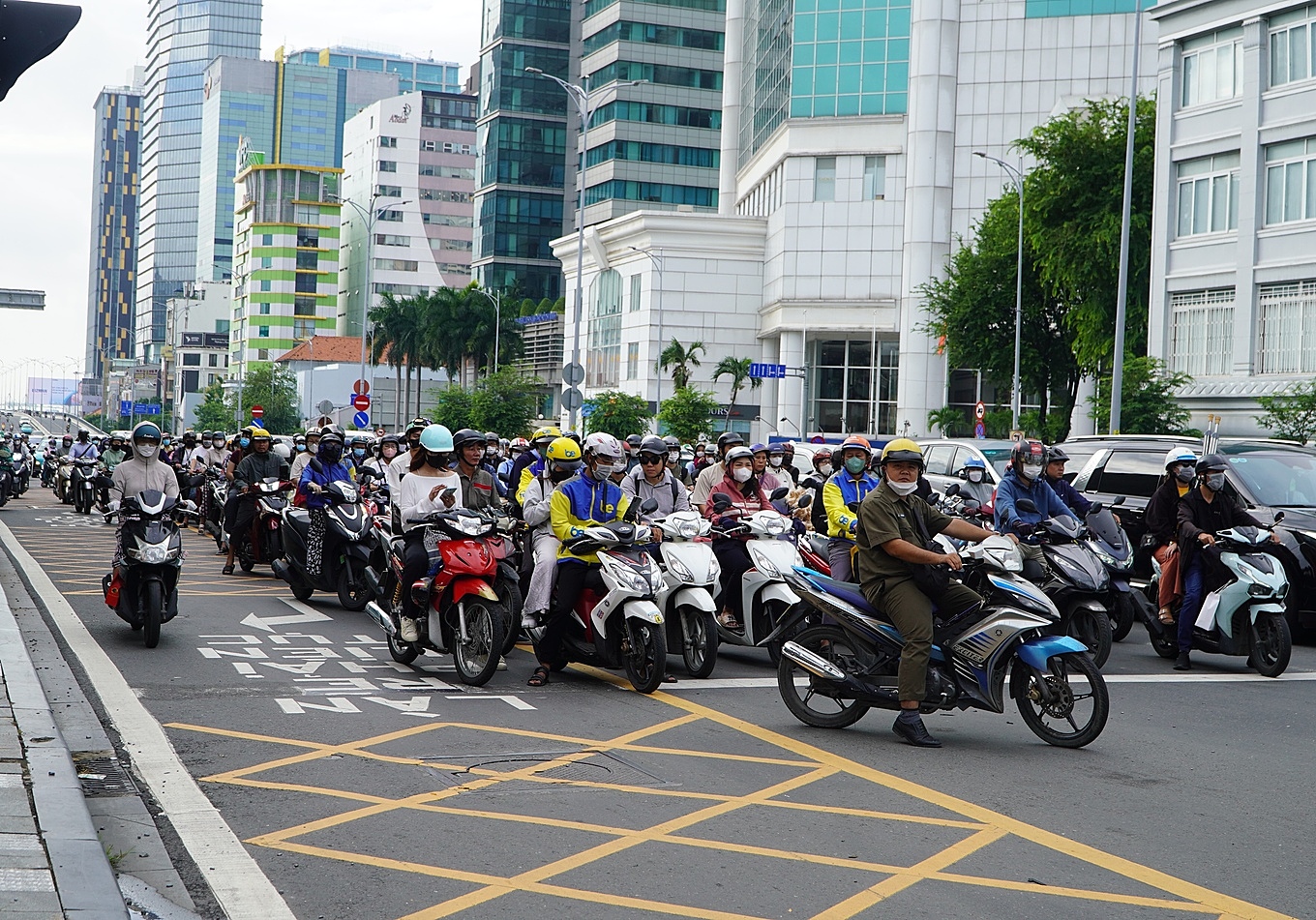On the morning of 24/9, hundreds of cars and motorbikes were stopped close together, waiting for the light to change at the Pasteur - Ly Tu Trong intersection (former District 1). On Pasteur Street, the yellow chevron markings, 1.5 meters wide and about 50 meters long, next to the sidewalk and designated for continuous right turns by motorbikes, were almost completely occupied by vehicles going straight. Those wanting to turn right were unable to, forced to honk their horns to ask for the right of way, but still found themselves stuck.
This is one of the intersections in Ho Chi Minh City recently marked with chevrons, combined with signals and painted with the words "two-wheeler lane, continuous right turn". This solution aims to reduce the number of vehicles stopped at red lights, thereby easing congestion. However, the chevron markings often become ineffective, as many vehicles, mostly motorbikes, stopping at red lights encroach upon them.
 |
Many vehicles parked in the chevron-marked lane prevent vehicles behind from turning right on Pasteur Street, 24/9. Photo: Giang Anh |
Many vehicles parked in the chevron-marked lane prevent vehicles behind from turning right on Pasteur Street, 24/9. Photo: Giang Anh
"Despite clear signs and markings, many people still squeeze into the space before the intersection while waiting for the red light," said Le Thanh, an employee at a nearby company. "This renders the right-turn lane useless and even leads to conflicts as vehicles from different directions try to move at the same time."
Similar situations occur at other intersections such as Nguyen Thi Minh Khai - Nam Ky Khoi Nghia, Cach Mang Thang Tam - Dien Bien Phu, where vehicles park on the chevron markings. Some people even mount the sidewalk or encroach on pedestrian crossings, adding to the traffic chaos.
According to drivers, in addition to a lack of awareness, the problem also stems from high vehicle density and narrow roads. Allocating space for right turns further constricts the straight lanes, forcing many people to stop on the chevron markings during peak hours.
Standard chevron markings are painted yellow and crisscrossed, signaling drivers not to stop within that area, but only to drive through. Violations are subject to fines of 400,000-600,000 VND for cars and 200,000-400,000 VND for motorbikes.
 |
Chevron markings at the intersection of Cach Mang Thang Tam - Dien Bien Phu, former District 3. Photo: Ha Giang |
Chevron markings at the intersection of Cach Mang Thang Tam - Dien Bien Phu, former District 3. Photo: Ha Giang
Ho Chi Minh City currently has more than 40 intersections organized for continuous right turns. This solution has been applied for many years, first at the Pham Van Dong - Phan Van Tri intersection (former Go Vap), and then expanded from April of this year when new regulations increasing traffic violation fines took effect, including stricter enforcement of right turns at red lights.
Some intersections allow both cars and motorbikes to make continuous right turns, such as Truong Dinh - Nguyen Thi Minh Khai, Ba Thang Hai - Thanh Thai, Phu Nhuan intersection, and Pham Van Dong - Phan Van Tri. Many others are designated for motorbike right turns only, such as Nguyen Trai - Nguyen Tri Phuong, Pasteur - Ly Tu Trong, and An Duong Vuong - Nguyen Tri Phuong.
In addition to the markings, the city has also installed nearly 800 "Yield to right-turning vehicles" signs and around 800 separate traffic lights for two-wheelers at eligible intersections.
Do Diep Gia Hop, Deputy Head of Traffic Works Maintenance and Operation (Department of Construction), said that the chevron markings and signs have improved traffic flow at many intersections. However, a limitation is that during peak hours, when traffic volume is high, the straight lanes are narrowed, forcing many vehicles to stop on the markings, obstructing right turns.
"Overall, this solution is still appropriate and effective, contributing to reducing congestion," said Mr. Hop, adding that the Department of Construction has assigned units to continue reviewing and adjusting the width of the right-turn lanes, while coordinating public awareness campaigns and strictly handling intentional violations.
 |
Many people stop at a red light to yield to right-turning vehicles at the Ton Duc Thang - Le Duan intersection, 24/9. Photo: Giang Anh |
Many people stop at a red light to yield to right-turning vehicles at the Ton Duc Thang - Le Duan intersection, 24/9. Photo: Giang Anh
Nguyen Ngoc Tuong, former deputy head of the Ho Chi Minh City Traffic Safety Committee, acknowledged that chevron markings are an effective solution, but they are difficult to implement effectively when traffic density is high and the habit of "squeezing into empty spaces" is prevalent during rush hour.
According to Mr. Tuong, public awareness campaigns should precede enforcement, with regular reminders to establish correct habits, and strict penalties only for intentional violations. "In reality, there are many situations where drivers accidentally stop on the markings because the surrounding area is already full, making it very difficult to avoid," he said.
In addition, Mr. Tuong suggested that infrastructure should be arranged reasonably, as many roads in the city center have only three lanes. Adding chevron markings can easily cause congestion. At some intersections, only short sections of markings should be applied. Moreover, signs should be added further in advance of the chevron markings to help drivers choose the correct lane for stopping at red lights, avoiding encroachment on the right-turn section.
Explanation of chevron markings. Video: Minh Hoang - Ky Anh
Giang Anh












